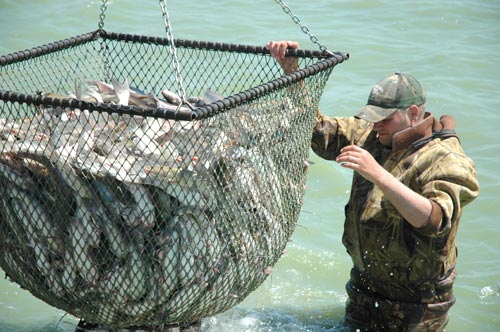September 8, 2010

Catfish farmers have until Sept. 23 to enroll in a recently approved governmental program to earn educational benefits and cash incentives.
Catfish farmers have struggled as the cost of production, the national economy and competition from foreign products have each taken a toll, pushing Mississippi acreage to its lowest levels in 30 years. In an effort to help farmers continue producing quality fish and remain competitive in the world market, the U.S. Department of Agriculture certified a Trade Adjustment Assistance for Farmers program on June 25.
Jimmy Avery, Extension aquaculture professor at Mississippi State University’s Delta Research and Extension Center, Stoneville, Miss., said the program will provide a minimum of 12 hours of educational benefits to qualified producers. The MSU Extension Service will conduct initial training sessions this fall and subsequent intensive workshops in early 2011.
“Developing the curriculum is a multistate effort. We will address ways to improve production efficiency, alternative market outlets and enterprise options for retired acreage,” Avery said. “Our goal is help catfish farmers develop a business plan that will reflect these adjustments.”
Avery said enrollment numbers have been low, but efforts are under way to make it easier for farmers to meet the eligibility requirements.
“The last time a similar program was offered, only about 35 percent of the qualified farmers took part,” Avery said. “But this time, the incentives are greater.”
Farmers can qualify for up to $4,000 after completing the initial training. If they complete an in-depth business plan, they will be eligible for up to $8,000 more.
The USDA’s Farm Service Agency is assisting the Foreign Agriculture Service by overseeing the enrollment process in Mississippi.
Ricky Carnegie, a program specialist with FSA, said there are several ways farmers may qualify for the program. All qualified participants must have sold catfish in 2009 and at least one of the previous three years.
“The other qualifying factors will require documentation of pounds sold or prices received,” Carnegie said. “All catfish producers should contact their county FSA office to find out how to qualify for the program.”
Avery said Mississippi acreage is down to 59,000, the lowest since the mid-1980s.
“Despite the drop in pond inventory, processors are on pace to match last year’s processing totals,” Avery said. “Processors need to stay in business and are asking for more fish. As a result, farmers are selling some smaller fish than in the recent past.”
Avery said this summer’s excessive heat drove up the cost of production. Farmers had to pump more ground water because of high evaporation rates and reduced rainfall throughout most of the Delta. Some farmers reported reduced feeding during the hottest days.
“The rate of acreage decline has started to level off, so we hope we are nearing a sustainable level. The price farmers receive has remained around 79 cents since March of this year. This is 2 to 3 cents higher than last year,” Avery said. “Feed prices are down 15 percent to 20 percent from a year ago.”
You May Also Like




